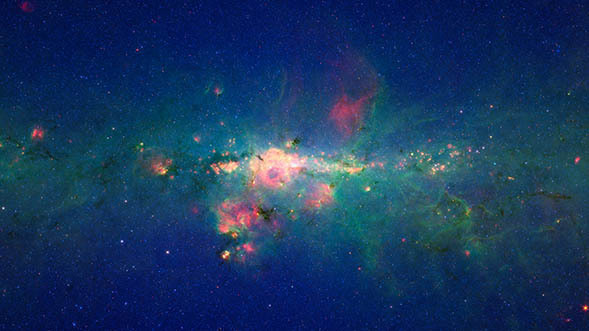
Spitzer was envisaged as the fourth and final element of NASA's family of Great Observatories, along with the Hubble Space Telescope (HST), the Chandra X-Ray Observatory (CXO) and the Compton Gamma-Ray Observatory (CGRO).
Together, NASA’s four Great Observatories have covered wavelengths from infrared to gamma rays. NASA’s Hubble Space Telescope (which observes primarily visible light) and the Chandra X-Ray Observatory are still operating, while the Compton Gamma Ray Observatory was decommissioned in 2000. Many of Spitzer’s great discoveries have been made in conjunction with other observatories both in space and on the ground.
The James Webb Space Telescope, set to launch in 2021, will observe in wavelengths that overlap the ones Spitzer observes. (During its “cold” or cryogenic mission, which ran from 2003 to 2009, Spitzer observed infrared wavelengths from 3 to 160 microns. Webb will observe from 0.6 through 28 microns.) Webb’s primary mirror has an area 50 times larger than Spitzer's, giving Webb higher resolution and the ability to see objects much farther away from Earth.
Webb will be able to conduct deeper and more detailed studies of many objects that Spitzer observed. By having a list of targets that Spitzer has already explored, Webb scientists can investigate the most interesting and scientifically valuable ones. Webb will be able to study in detail questions that Spitzer began to explore, such as: When did the earliest galaxies form? How do massive galaxies form and evolve and grow? How do planetary systems form around stars like the Sun? What molecules are found in the atmospheres of Earth-like planets orbiting stars smaller than our Sun, or planets hotter than Earth around Sun-like stars?
Spitzer’s legacy will also help inform NASA's upcoming Nancy Grace Roman Space Telescope and the European Space Agency’s Euclid space telescope, both of which will produce large-scale maps of the infrared universe. The combination of Spitzer, Roman and Euclid data will cover large regions of the sky, and provide new insights into how the most massive galaxies formed and evolved in the early universe. Spitzer has also been a pathfinder for determining the masses of planets orbiting outside the snow line of their systems (the boundary beyond which volatile chemicals such as water, carbon dioxide and ammonia freeze into ice). Roman will build on this gradually, creating a census of Jupiter and even Mars-type planets beyond the snow line.



